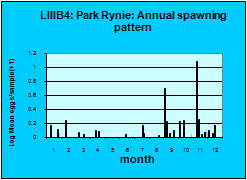Serranidae: L III B4
Epinephelus malabaricus (Schneider, 1801) and E. andersoni Boulenger, 1903
Malabar rockcod







|
Egg diameter in µm |
Number of oil globules |
Diameter of oil globule in µm |
Yolk texture |
Perivitelline space |
Position of oil globule at hatch |
Gut length at eye- pigment stage |
Myomeres |
|
840-950 |
1 |
170-200 |
clear |
narrow |
stern |
53% of NL |
24 |
Egg: When fresh, the egg has a yellow hue, and a pink oil globule. The yolk surface is rough. Usually no pigment is seen on the developing larva within the egg (A). Incubation is 30-35 hours.
Larva: This larva was separated from LIIID2, purely on the basis of the lack of yellow pigment in the mid-tail. Careful examination on a white background, will reveal black pigment along the notochord, which gathers over the gut and mid-tail in the 3-4 day larva (C & D), at which stage the larva was noted to be slimy, and to curl when harassed. The stringy wedges of white pigment in the finfolds in mid-tail, are also characteristic. B: 1 day, C: 3 days, D: 4 days, (24°C). Plate E: 4 days : Epinephalus andersoni ex ORI
The larva of E. andersoni is included here, because the NH larva, from the ORI eggs, did not have yellow pigment on the mid-tail. However it also did not have the white wedges of pigment in the finfolds (E). Locally collected adults of Cephalopholis miniata, C. sexmaculata and C. sonnerati, Epinephelus albomarginatus, E. andersoni, E. areolatus, E. caeruleopunctatus, E. chabaudi, E. fasciatus, E. flavocaeruleus, E. longispinis, E. macrospilos, E. malabaricus, E. marginatus, E. poecilonotus, E. posteli, E. rivulatus and E. tukula, and Variola louti have been sequenced (BOLD). Of the four larvae barcoded to date, 1 each, matches andersoni, malabaricus, marginatus and poecilonotus (but see LIIID2).

| linked samples | Offshore | Inshore |
| Eggs | 26 | 20 |
| Hits | 13 | 12 |
This egg was uncommon off Park Rynie, and only seen in small numbers. Late winter and spring were the peak spawning times (blue graph). It was not seen in the DHM samples. The Park Rynie linked samples showed slightly more of these eggs offshore (57%), indicating spawning in 20-30m water depth, but from very low numbers, and the multiple species complicate the picture. However this is probably true for E. malabaricus, but E. andersoni almost certainly spawns closer inshore (personal observation). See Section 7.3 and Table 1 of the Introductory Notes, for more information on the linked samples.